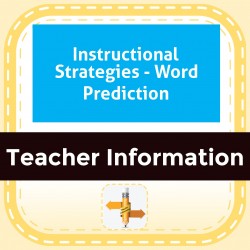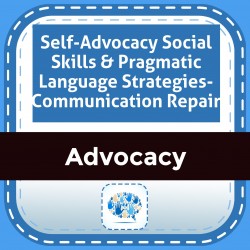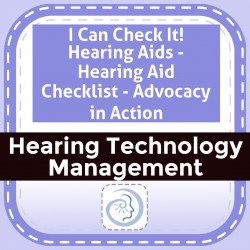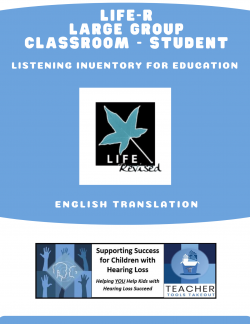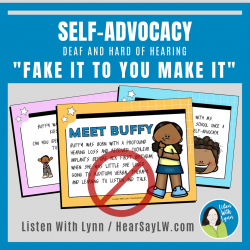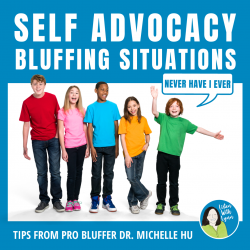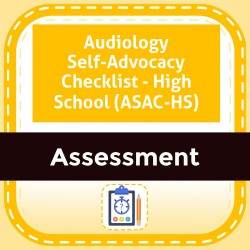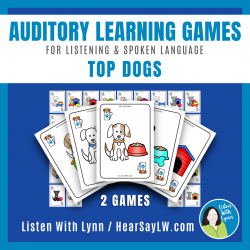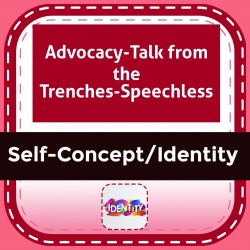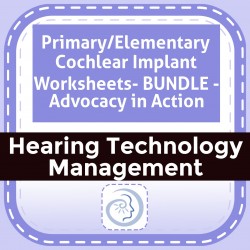Ability Levels
Categories
Resource Types
Age/Grade Range
CCSS
Anchor Standard
Speaking & Listening
Language
Reading
Instructional Strategies - Word Prediction
$ 0
the brain’s ability to predict words is a key component of communication success. We use it in a conversation by predicting what the next person will say. See BUNDLE at S0XTEA0815.
Self-Advocacy Social Skills & Pragmatic Language Strategies- Communication Repair
$ 395
Learning how to repair communication early is a critical skill, especially for students who are deaf or hard of hearing. Miscommunication leads to social and academic problems having a negative impact
...
on students. Use these activities designed for basic to advanced levels to teach communication repair strategies. Includes communication checklists, task cards, and readings.
I Can Check It! Hearing Aids - Hearing Aid Checklist - Advocacy in Action
$ 1
Worksheet for young students to check off A) does the battery work? B) is the earmold clean? C) can I put my hearing aid on? D) can I hear the teacher. Large spaces for students to mark or stamp. One
...
worksheet to be used each week. Fillable.
Large Group Student LIFE
$ 4
This checklist is designed to be a pretest/post-test when a Classroom Amplification Distribution System (CADS or soundfield amplification) is used in a classroom in which large group instruction is pr
...
esented. It can be used with a selected subgroup of students, or all students can be asked to complete the checklist. Each student rates his/her general responsiveness during instruction on a 1-5 rating scale. Includes room for minimal comments. Results will be most valid for students in grade 4 or ages 9-10 and above.
SELF-ADVOCACY Fake It To You Make It Communication Success Activity
$ 7
FAKE IT TO YOU MAKE IT is a fun and motivating no-prep grab & go SELF-ADVOCACY resource for elementary and middle school-aged kids who are deaf and hard of hearing. If you're looking for a new twist t
...
st to self-advocacy lessons you are at the right place.THIS RESOURCE HAS THREE PARTS:PART ONE:The part of the lesson and self-advocacy content is taught through a colorful nine-page story.Buffy the main character hears with cochlear implants and is relatable for kids that are deaf and hard of hearing. Kids love the comic-like story format!The story is great for auditory comprehension, story recall, and re-telling activities.PART TWO:Next, we meet eight of Buffy's friends who are also deaf and hard of hearing.There are eight situations - one for each friend.The goal is to identify different ways the kids try to bluff or fake it to get by.Each scenario is a common situation that kids with hearing loss face at school, at home, with peers, and in their community.Talking points with guided questions/discussion prompts for each scenario.Kids grapple with the challenging situations to foster self-advocacy learning.PART THREE:Buffy has learned a lot about self-advocacy and shares -Tips For Communication Success.Most importantly Buffy learned that bluffing doesn't work!INSTRUCTIONS1. The therapist, teacher, or parent reads the story about Bluffy and leads a discussion.2. The children listen to each of the eight scenarios. Each scenario can be taught as individual mini-lessons and introduced over time. One or more scenarios per lesson/session.3. The adult uses the questions and discussion prompts to foster self-advocacy learning.WHAT'S INCLUDED:✧ A PDF story that teaches the lesson content.✧ 8 situations or mini-lessons✧ Comic-like pictures illustrate the situations✧ Talking points with guided questions/discussion prompts✧ Advocacy StrategiesDIGITAL - NO PRINT The PDF can be opened and played with your iPad or tablet. When playing on a computer, open and use a PDF reader such as Adobe Acrobat Reader DC which is free. ➼ PRINT - This is an option but will use a great deal of ink due to the graphics.◈ ◈ ◈ ◈ ◈ ◈ ◈ ◈ ◈ ◈ ◈ ◈ ◈ ◈ ◈ ◈ ◈ ◈ ◈ ◈ ◈ ◈ ◈ ◈ ◈ ◈ ◈ ◈ ◈ ◈ CUSTOMER TIPS➼ Questions? EMAIL ME before purchasing this resource or anytime later♥ Sign-up HERE for the Listen With Lynn Emails♥ Let’s ConnectInstagramFacebookKeep up your good work. I am blessed to help along the way.Thanks so much!Lynn Wood
Self-Advocacy Bluffing Situations - Never Have I Ever Activity
$ 7
18 Mini-Lessons target BLUFFING and foster self-advocacy and personal responsibility for kids that are deaf and hard of hearing. This resource is based on the NEVER HAVE I EVER game which is fun and m
...
and motivating for elementary and middle school-aged kids.Bluffing is pretending to hear or acting in a way that shows you understand what is being said when you are not following the conversation. Bluffing, faking, and pretending are common habits of most people with hearing loss.INCLUDED:Tips from Pro-Bluffer, Dr. Michelle Hu, a pediatric audiologist and bilateral cochlear implant recipient. Michelle knows what it is like to bluff and shares words of wisdom based on her life experiences. Follow Michelle on Instagram as she shares her hearing loss journey.18 Never Have I Ever Mini-Lessons✧ Real photos that illustrate the social situations and scenarios✧ Each situation pictures a student who says: (example) "Never Have I Ever pretended that I didn’t want to join in the game.”✧ The kids' self-talk or comments. (example) "It’s easier to not play rather than mishear and mess up."✧ Talking points with guided questions/discussion prompts.Children grapple with BLUFFING in challenging situations. Discussing possible plans of action, and exploring positive coping and communication repair strategies within a supported environment is important. Self-advocacy success requires knowledge, skills, and importantly ample practice opportunities.➼ DIGITAL - NO PRINT can be opened and played with your favorite PDF reader app on a tablet. When playing on a computer, open and use a PDF reader such as Adobe Acrobat Reader DC which is free. ➼ PRINT - Print out the 18 situations and a copy of the Discussion prompts and questions.◈ ◈ ◈ ◈ ◈ ◈ ◈ ◈ ◈ ◈ ◈ ◈ ◈ ◈ ◈ ◈ ◈ ◈ ◈ ◈ ◈ ◈ ◈ ◈ ◈ ◈ ◈ ◈ ◈ ◈ CUSTOMER TIPS➼ Questions? EMAIL ME before purchasing this resource or anytime later.♥ Sign-up HERE for the Listen With Lynn Emails♥ Let’s ConnectInstagramFacebookKeep up your good work. I am blessed to help along the way.Thanks so much!Lynn Wood
Audiology Self-Advocacy Checklist - High School (ASAC-HS)
$ 0
Checklist identifying student skills and knowledge about hearing loss, audiogram, amplification, and successful communication in the classroom. For high school age students
TOP DOGS Two Listening and Language Auditory Learning Games
$ 7
If you looking for TWO listening and language games to play all year long you’ve come to the right place! These fun dog-loving games are an easy, stress-free way to practice listening skills, and buil
...
s, and build spoken language, descriptive vocabulary, questioning skills, and auditory processing skills.YOU CAN TARGET: These games target and can build auditory memory, comprehension, processing, descriptive vocabulary, grammar, using clear speech, and social skills.TWO GAMES IN ONE RESOURCE: Game 1: TOP DOG* is a two-player game where players use differential yes or no questions to listen and isolate a specific dog based on critical elements. Game 2: GO FETCH* is a two or more-player game where players ask questions and listen to match pairs of dogs and their belongings cards. Kids love these cute and cuddly dogs and ask to play time and time again. I have used versions of both of these games SUCCESSFULLY for years while working with children who are deaf and hard of hearing, those with auditory processing needs, and students who need to develop listening skills.* These games are versions of the traditional Go Fish and Guess Who games that are played with rules to target listening and spoken language skills. Both games can easily be adapted to meet a child’s ability level. The cards can be sorted into sets of fewer cards which would be an easier listening set. Use all 36 different card designs for a more complex game.INCLUDES:✧ A complete guide with detailed instructions ✧ 36 enticing colorful game cards used for both TOP DOG and GO FETCH!✧ A digital gameboard for Top Dog✧ Listening and Spoken Language TipsFACE TO FACE - TELETHERAPY - HOME✢ PRINT - One-time easy prep. ✢ DIGITAL - The Top Dog digital gameboard can be opened and played with your favorite PDF reader app on a tablet or iPad. Tokens can be placed directly on the screen.on a computer. Open the PDF game board with the 36 spring egg images and use a PDF reader such as Adobe Acrobat Reader DC which is free. The listener used the annotation tools to mark the cards like Lotto.YOU ASKED. I LISTENED. I created a second dog-themed resource based on many of your requests and the rave reviews that kids are so motivated by my LOST DOG and MY PET CAT animal activities. You will want all three resources in your Listening and Language Toolbox.PLEASE NOTE: This activity and the LOST DOG resource contain many of the same images that are bright, enticing, and vocabulary rich. However, these two resources target completely different auditory and language-based goals.◈ ◈ ◈ ◈ ◈ ◈ ◈ ◈ ◈ ◈ ◈ ◈ ◈ ◈ ◈ ◈ ◈ ◈ ◈ ◈ ◈ ◈ ◈ ◈ ◈ ◈ ◈ ◈ ◈ ◈ CUSTOMER TIPS:➼ Questions? Email me before purchasing this resource or anytime later.➼ Sign-up HERE for the Listen With Lynn Emails♥ Let’s Connect:InstagramFacebookKeep up your good work. I am blessed to help along the way.Thanks so much!Lynn Wood
Advocacy-Talk from the Trenches-Speechless
$ 2
Engage teens in discussion about what being deaf means to them. Author reflects on experience reading Huckleberry Finn, and seeing the words "deaf and dumb" for the first time. See BUNDLE at S0XSOC739
...
.
Primary/Elementary Cochlear Implant Worksheets- BUNDLE - Advocacy in Action
$ 495
BUNDLE - Worksheets for primary level instruction on cochlear implants. There are 12 worksheets including instruction on a cochlear implant routine and maintenance checklist, labeling implant parts, a
...
flowchart for troubleshooting, and a cochlear implant parts game. Bundle IDs 0484-0487, 0506-0509.
 Your browser is out of date. For best experience switch to latest updated Browser.
Your browser is out of date. For best experience switch to latest updated Browser.
 Get Chrome
Get Chrome Get Edge
Get Edge Get Firefox
Get Firefox